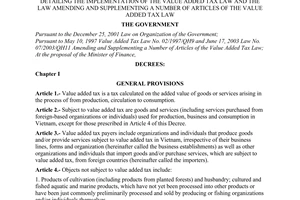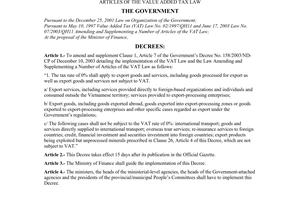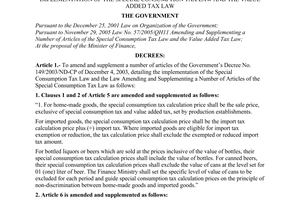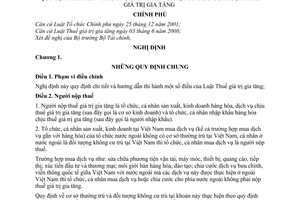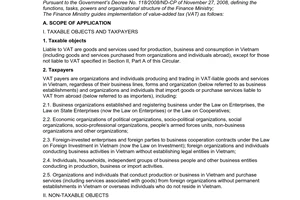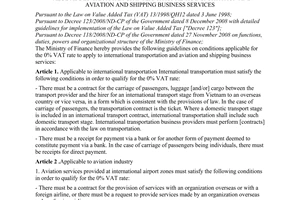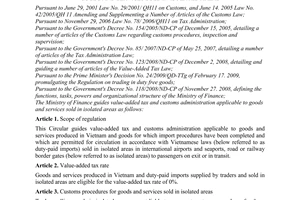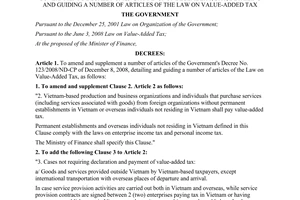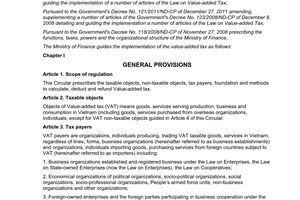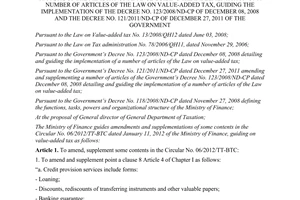Decree no. 123/2008/ND-CP of December 8, 2008, detailing and guiding the implementation of a number of articles of the Law on Value-Added Tax. đã được thay thế bởi Decree No. 209/2013/ND-CP guiding implementation of Law on value-added tax và được áp dụng kể từ ngày 01/01/2014.
Nội dung toàn văn Decree no. 123/2008/ND-CP of December 8, 2008, detailing and guiding the implementation of a number of articles of the Law on Value-Added Tax.
|
THE
GOVERNMENT |
SOCIALIST
REPUBLIC OF VIET NAM |
|
No. 123/2008/ND-CP |
Hanoi, December 8, 2008 |
DECREE
DETAILING AND GUIDING THE IMPLEMENTATION OF A NUMBER OF ARTICLES OFTHE LAW ON VALUE-ADDED TAX
THE GOVERNMENT
Pursuant to the December 25,
2001 Law on Organization of the Government;
Pursuant to the June 3, 200S Law on Value-Added Tax;
At the proposal of the Minister of Finance,
DECREES:
Chapter 1
GENERAL PROVISIONS
Article 1.- Governing scope
This Decree details and guides the implementation of a number of articles of the Law on Value-Added Tax.
Article 2.-Taxpayers
1. Value-added taxpayers include organizations and individuals producing or trading in goods or services subject to value-added tax (below referred to as business establishments) and organizations and individuals importing goods subject to value-added tax (below referred to as importers)
2. Vietnam-based production and business organizations and individuals that purchase services (including services associated with goods) from foreign organizations without permanent establishments in Vietnam or overseas individuals not residing in Vietnam shall pay value-added tax.
Vietnamese organizations and individuals that purchase such services as repair of means of transport, machinery or equipment; advertisement and marketing; investment and trade promotion; goods sale brokerage: or training; or share with foreign partners charges for international post or telecommunications services provided outside Vietnam are not required to pay value-added tax.
Permanent establishments and non-residents specified in this Clause must comply with the laws on enterprise income tax and personal income tax.
The Ministry of Finance shall specify this Clause.
Article 3.- Non-taxable objects
Objects not liable to value-added tax are specified in Article 5 of the Law on Value-Added Tax.
1. Preliminarily processed products specified in Clause l, Article5oftheLaw on Value-Added Tax are products which have only been cleaned, dried, peeled, pitted, sliced, salted, frozen or otherwise ordinarily preserved.
2. Salt products specified in Clause 4, Article 5 of the Law on Value-Added Tax are products the principal component of which has the chemical formula NaCl.
3. Life insurance specified in Clause 7. Article 5 of the Law on Value-Added Tax covers human health insurance and accident insurance in a life insurance package.
4. Services provided for in Clause 8, Article 5 of the Law on Value-Added Tax are specified as follows:
a/ Credit provision services include loan provision; discount of negotiable instruments and other valuable papers; guarantee; financial leasing; and other forms of credit provision under law, which are provided by financial or credit institutions in Vietnam.
b/ Securities trading covers securities brokerage, securities dealing, securities issuance underwriting, securities investment consultancy, securities depository, management of securities investment funds, management of securities investment portfolios, market organization services provided by stock exchanges or securities trading centers, and other trading activities under the securities law.
c/ Capital transfer covers the transfer of part or the whole of the invested capital amount, including the sale of enterprises to other enterprises for production and business; securities transfer; and other forms of capital transfer under I aw.
5. Healthcare services specified in Clause 9, Article 5 of the Law on Value-Added Tax include transportation, test, screening, radiograph and blood and blood preparations used for patients.
6. For the renovation, repair or construction of works specified in Clause 12, Article 5 of the Law on Value-Added Tax, which is funded with capital other than people's contributions (including contributed capital amount and financial supports of organizations and individuals) or humanitarian aid not exceeding 50% of the total capital used for those works, the whole value of the works is not subject to tax.
Social policy beneficiaries include people with meritorious services under the law on people with meritorious services; social relief beneficiaries who enjoy state budget allowances; people classified as poor or living just above the poverty line; and other cases provided for by law.
7. Mass transit services specified in Clause 16, Article 5 of the Law on Value-Added Tax covers mass transit by bus or tramcar along routes within provinces or urban centers and in their vicinities as prescribed by competent state agencies.
8. Aircraft specified in Clause 17, Article 5 of the Law on Value-Added Tax covers also aircraft engines.
The Ministry of Planning and Investment shall assume the prime responsibility for. and collaborate with concerned agencies in, promulgating a list of machinery, equipment and supplies which can be manufactured at home as a basis for differentiating them from those which cannot be manufactured at home and need to be imported for scientific research and technological development activities; a list of machinery, equipment, spare parts, special-purpose means of transport and supplies which can be manufactured at home as a basis for differentiating them from those which cannot be manufactured at home and need to be imported for prospecting, exploring and developing oil and gas fields; a list of aircraft, drilling platforms and ships which can be manufactured at home as a basis for differentiating them from those which cannot be manufactured at home and need to be imported for the formation of enterprises' fixed assets or hired from foreign parties for production and business activities or for lease.
9. The Ministry of Defense and the Ministry of Public Security shall assume the prime responsibility for, and reach agreement with the Ministry of Finance on, specifying special-purpose weapons and military equipment for security and defense purposes mentioned in Clause 18, Article 5 of the Law on Value-Added Tax.
10. Imported goods provided for in Clause 19, Article 5 of the Law on Value-Added Tax are specified as follows:
a/ Goods imported as humanitarian aid or nonrefundable aid must be approved by competent state agencies.
b/ Gifts for state agencies, political organizations, socio-political organizations, sociopolitical-professional organizations, social organizations, socio-professional organizations or people's armed forces units must comply with the law on gifts.
c/ Quotas of goods imported as gifts for individuals in Vietnam must comply with the law on gifts.
11. In case of transfer of technologies or intellectual property rights specified in Clause 21, Article 5 of the Law on Value-Added Tax. which is accompanied by machinery or equipment transfer, the value of transferred technologies or intellectual property rights is not subject to value-added tax. If this value cannot be separately determined, value-added tax shall be imposed on the total value of transferred technologies or intellectual property rights and accompanied machinery and equipment.
12. Unprocessed exploited natural resources and minerals specified in Clause 23, Article 5 of the Law on Value-Added Tax are natural resources and minerals not yet processed into other products.
Chapter II
TAX BASES AND TAX CALCULATION METHODS
Article 4.- Taxable price
Taxable price is specified in Article 7 of the Law on Value-Added Tax.
1. In case of purchase of services specified in Clause 2, Article 2 of this Decree, the taxable price is the payment price exclusive of value-added tax indicated in the service purchase contract.
2. For goods and services used for barter, internal consumption or donation, the taxable price is the price for calculating value-added tax on goods and services of the same or equivalent kinds at the time of barter or donation.
Goods and services used for internal consumption specified in this Clause are those delivered or supplied by business establishments for consumption, excluding goods and services used for those establishments' production and business activities.
3. For real estate trading, the taxable price is the real-estate transfer price minus (-) the actual land price at the time of transfer. If the actual land price at the time of transfer is lower than the land price set by provincial-level People's Committees, the to-be-subtracted land price is that set by provincial-level People's Committees at the time of transfer.
In case of infrastructure construction and commercial operation, or construction of houses for sale, transfer or lease, the taxable price is the sum collected according to the project execution payment schedule indicated in contracts.
4. For electricity of a hydropower plant being a dependent cost-accounting unit of the Vietnam Electricity Group, the taxable price for determining the value-added tax amount to be paid in the locality where the plant is based is equal to 60% of the preceding year's average commodity electricity-selling price exclusive of value-added tax.
5. For casinos, prize-winning video games or betting entertainment services, the taxable price is excise tax-inclusive earnings from these services, excluding prizes already paid to customers.
6. Taxable prices of goods and services specified in Clause 1, .Article 7 of the Law on Value-Added Tax include also surcharges and additional charges earned by business establishments.
The Ministry of Finance shall specify taxable prices mentioned in this Article.
Article 5.- Time for determining value-added tax
1. The time for determining value-added tax on goods is the time of transferring goods ownership or use right to purchasers, regardless of whether money has been collected or not.
2. The time for determining value-added tax on services is the time of completing the provision of services or the time of making service provision invoices, regardless of whether money has been collected or not.
3. The Ministry of Finance shall specify the time for determining value-added tax in other cases.
Article 6.-Tax rates
Value-added tax rates are specified in Article 8 of the Law on Value-Added Tax.
1. The tax rate of 0% applies to exported goods and services, international transportation and goods and services not subject to value-added tax specified in Article 5 of the Law on Value-Added Tax upon exportation, except goods and services specified at Point e of this Clause.
a/ Exported goods include goods exported abroad or sold into non-tariff areas or other cases in which goods are regarded as exports under the commercial law.
b/ Exported services include services provided directly to overseas organizations or individuals or organizations and individuals in non-tariff areas.
Overseas organizations are organizations without permanent establishments in Vietnam and other than value-added tax payers in Vietnam.
Overseas individuals include foreigners not residing in Vietnam and overseas Vietnamese who stay outside Vietnam during the time of service provision.
Organizations and individuals in a non-tariff area are those having business registration and other cases specified by the Prime Minister.
c/ To be eligible for the tax rate of 0%, exported goods and services specified at Points a and b of this Clause must satisfy the following conditions:
- Having a contract on sale or processing of exported goods or entrusted processing of exported goods or a service provision contract signed with an organization or individual overseas or in a non-tariff area;
- Having via-bank payment documents for exported goods or services and other documents under law; or customs declarations, for exported goods.
Payment for exported goods and services made in the form of clearing between exported and imported goods and services, or debt payment on behalf of the State is also regarded as via-bank payment.
d/ International transportation mentioned in this Clause covers transportation of passengers, luggage and cargo along international routes from Vietnam abroad or vice versa. If international transportation contracts cover domestic transportation routes, international transportation also covers domestic routes.
e/ The tax rate of 0% does not apply to the following cases: offshore re-insurance; offshore transfer of technologies or intellectual property rights; offshore capital transfer, credit provision or securities investment; derivative financial services; post and telecommunications services; exported products being unprocessed exploited natural resources or minerals specified in Clause 12, Article 3 of this Decree; goods and services provided to individuals without business registration in non-tariff areas.
2. The tax rate of 5% is applied to the goods and services defined in Clause 2, Article 8 of the Law on Value-Added Tax, and specified as follows:
a/ Clean water for production and daily life specified at Point a. Clause 2, Article 8 of the Law on Value-Added Tax excludes bottled drinking water and other beverages which are subject to the tax rate of 10%.
b/ Products specified at Point b. Clause 2, Article 8 of the Law on Value-Added Tax include:
- Fertilizers, including organic fertilizers, inorganic fertilizers, microbiological fertilizers and other fertilizers;
- Ores for fertilizer production, including those used as raw materials for fertilizer production;
- Pesticides, fungicides and plant and animal growth stimulants.
c/ Feeds for cattle, poultry and other domestic animals specified at Point c, Clause 2, Article 8 of the Law on Value-Added Tax include processed or unprocessed products, such as bran, offals, assorted oil cakes, fish paste, bone meal.
d/ Product preliminary processing and preservation services specified at Point d, Clause 2, Article 8 of the Law on Value-Added Tax include drying, peeling, pitting, slicing, grinding, freezing, salting or other ordinary methods of preservation.
dd/ Fresh and live foods specified at Point g, Clause 2, Article 8 of the Law on Value-Added Tax include foods not yet cooked or processed into other products.
Unprocessed forest products specified at Point g, Clause 2, Article 8 of the Law on Value-Added Tax include exploited natural forest products, such as rattan, bamboo, mushrooms, Jew's ear (auricularia polytricha): roots, leaves, flowers, medicinal plants, resin and other forest products.
e/ The Ministry of Finance shall promulgate, after reaching agreement with the Ministry of Health, a list of pharmaco-chemical products and pharmaceuticals used as raw materials for the manufacture of curative and preventive medicines specified at Point k, Clause 2, Article 8 of the Law on Value-Added Tax.
Article 7.- Tax credit method
The tax credit method is specified in Article 10 of the Law on Value-Added Tax.
1. The payable value-added tax amount calculated according to the tax credit method is the output value-added tax amount minus (-) the creditable input value-added tax amount.
2. The output value-added tax amount is the total value-added tax amount on sold goods or services indicated on the value-added invoice.
The value-added tax indicated in the value-added invoice is the taxable price of sold taxable goods or services multiplied by (x) the value-added tax rate for such goods or services.
In case documents indicating the payment price inclusive of value-added tax are used, the output value-added tax is the payment price minus (-) the taxable price determined under Point j, Clause 1, Article 7 of the Law on Value-Added Tax.
3. The creditable input value-added tax amount is determined based on:
a/ The value-added tax amount indicated on the value-added invoice of goods or service purchase; and the document proving the payment of value-added tax on imported goods, or value-added tax payment in the case of service purchase specified in Clause 2, Article 2 of this Decree.
For purchased goods and services for which documents indicating payment prices inclusive of value-added tax are used, the creditable input value-added tax amount is the payment price minus (-) the taxable price specified at Point j, Clause 1, Article 7 of the Law on Value-Added Tax.
b/ Conditions for input value-added tax credit are specified in Clause 2, Article 9 of this Decree.
Article 8.- Method of calculation of tax based directly on added value
The method of calculation of tax based directly on added value is specified in Article 11 of the Law on Value-Added Tax.
1. The payable value-added tax amount according to the method of calculation of tax based directly on added value is the added value of sold taxable goods or services multiplied by (x) the tax rate for such goods or services.
a/ The added value of goods or services is the selling price of goods or services minus (-) the purchase price of such goods or services.
The selling price of goods or services is the actual selling price indicated on the goods or service sale invoice, inclusive of value-added tax, surcharges and additional charges earned by the seller.
The purchase price of goods or services is the value, inclusive of value-added tax, of purchased or imported goods or services, which are used for the production or trading of sold taxable goods or services.
b/ For business establishments which sell goods or services with sufficient invoices and documents as prescribed and are able to determine the exact sale turnover but have insufficient invoices of purchase of input goods or services, added value is the turnover multiplied by (x) the percentage (%) of the added value calculated on the turnover.
The percentage (%) of the added value calculated on the turnover serving as a basis for determining the added value is specified as follows:
- Commercial (goods distribution or provision) activities: 10%;
- Services, construction (except construction involving the supply of raw materials and materials): 50%;
- Production, transportation, services provided together with goods, construction involving the supply of raw materials and materials: 30%.
c/ Business activities with insufficient invoices or documents or business establishments which fail to observe or fully observe the laws on accounting, invoices and documents, are subject to value-added tax payment according to the method of fixing tax amounts specified in Article 38 of the Law on Tax Administration.
The Ministry of Finance shall specify the method of fixing tax amounts specified at this Point.
2. The method of calculation of tax based directly on added value applies to:
a/ Business establishments, individuals and households that fail to observe or fully observe the laws on accounting, invoices and documents;
b/ Foreign organizations and individuals doing business in Vietnam not under the Investment Law and other organizations that fail to observe or fully observe the laws on accounting, invoices and documents.
c/ Gold, silver and gem trading activities.
Business establishments paying tax according to the tax credit method which trade in gold, silver or gems and process gold, silver and gem products must separately account gold, silver or gem trading activities for the application of the method of calculation of tax based directly on added value.
Chapter III
TAX CREDIT AND REFUND
Article 9.- Credit of input value-added tax
Input value-added tax credit is specified in Article 12 of the Law on Value-Added Tax.
1. Business establishments which pay value-added tax according to the tax credit method are entitled to input value-added tax credit as follows:
a/ Input value-added tax on goods or services used for the production or trading of goods or services subject to value-added tax may be wholly credited;
b/ For goods or services used for the production and trading of goods or services both subject and not subject to value-added tax, only the input value-added tax amount on goods or services used for the production and trading of goods or services subject to value-added tax may be credited. Business establishments shall separately account creditable and non-creditable input value-added tax amounts; if separate accounting cannot be conducted, the creditable input tax shall be calculated based on the ratio (%) between the turnover subject to value-added tax and the total turnover of sold goods or services.
The input value-added tax on fixed assets used for the production and trading of goods or services both subject and not subject to value-added tax may be wholly credited.
The input value-added tax on fixed assets in the following cases shall not be credited but shall be included in historical cost of fixed assets: special-purpose fixed assets used for the manufacture of weapons and military equipment for security and defense purposes; fixed assets being houses used as working offices and special-purpose equipment for credit activities of credit institutions, re-insurance businesses, life insurance enterprises, securities trading enterprises, hospitals or schools; civil aircraft and yachts not for commercial transportation of cargo or passengers, or for tourist or hotel business.
For fixed assets being passenger cars of 9 seats or less (except cars for commercial transportation of cargo or passengers, or for tourist or hotel business) which are valued at over VND 1.6 billion, the input value-added tax amount corresponding to the amount in excess of VND 1.6 billion will not be credited.
c/ The input value-added tax on goods or services used for die production and trading of goods or services not subject to value-added tax is not credited, except for cases specified at Points d and e of this Clause.
d/ The value-added tax on goods or services purchased by business establishments for the production and trading of goods or services provided to foreign organizations or individuals or international organizations used as humanitarian aid or non-refundable aid specified in Clause 19, Article 5 of the Law on Value-Added Tax is wholly credited.
e/ The input value-added tax on goods or services used for prospecting, exploring and developing oil and gas fields is wholly credited.
h/ The input value-added tax arising in a month shall be declared and credited upon the determination of the payable tax amount of that month. In case a business establishment detects errors in the declared or credited input value-added tax amount, additional declaration and credit may be conducted; the time limit for additional declaration and credit is 6 months from the time of detecting errors.
h/ Business establishments may account the non-creditable input value-added tax amount as an expense for calculating enterprise income tax or include it in the historical cost of fixed assets.
2. Conditions for input value-added tax credit:
a/ Having an value-added invoice of purchased goods or services or a document proving the payment of value-added tax on goods at the stage of importation, and a document proving the value-added tax payment in case of service purchase specified in Clause 2, Article 2 of this Decree.
b/ Having a via-bank payment document of purchased goods or services, except goods or services valued at under VND 20 million upon each purchase.
For goods or services purchased by deferred or installment payment, which are valued at over VND 20 million, business establishments shall, based on goods or service purchase contracts, value-added invoices and via-bank payment documents, declare and credit the input value-added tax. In case of non-availability of via-bank payment documents because the contractual payment time is not due. business establishments may still declare and credit the input value-added tax. As of the contractual payment time, if via-bank payment documents are unavailable, business establishments are not entitled to input value-added tax credit but shall declare and readjust the credited amount of input value-added tax.
For goods or services purchased by clearing between the value of purchased goods or services and the value of sold goods or services, such clearing is also regarded as via-bank payment. After clearing, if the remaining value paid in cash is VND 20 million or more, tax credit is allowed only for cases in which via-bank payment documents are available.
In case goods or services valued at under VND 20 million are purchased from a supplier many times in a day, bringing the total value of purchased goods or services to over VND 20 million, tax credit is allowed only for cases in which via-bank payment documents are available.
c/ Exported goods and services, apart from the conditions specified at Points a and b of this Clause, must also fully satisfy the conditions specified at Point c, Clause 1, Article 6 of this Decree.
Article 10.- Value-added tax refund
Value-added tax refund is specified in Article 13 of the Law on Value-Added Tax.
1. Business establishments which pay tax according to the tax credit method and have some input value-added tax amount not yet fully credited for three consecutive months will be refunded such value-added tax amount.
2. For new business establishments under investment projects which have registered business and registered to pay value-added tax according to the tax credit method, or oil and gas field-prospecting, exploring and developing projects which are being invested and do not yet operate, and have an investment period of one year or longer, they are entitled to value-added tax refund on a yearly basis for goods or services used for investment. When the accumulated amount of value-added tax on goods or services purchased for investment reaches VND 200 million or more, it will also be refunded.
3. For operating business establishments (except enterprises making cost-accounting according to the whole sector) paying value-added tax according to the tax credit method and having investment projects on new production units in provinces or centrally run cities other than those where they are headquartered, which are being invested and do not yet operate and register business and tax payment, they will be refunded value-added tax on goods or services purchased for such investment when it reaches VND 200 million or more. In this case, business establishments shall make separate tax declarations and tax refund dossiers.
4. Business establishments which export goods or services in a month and have a non-credited input value-added tax amount of VND 200 million or more will be refunded such tax amount in the month.
5. Business establishments making tax. finalization upon separation, split, dissolution, bankruptcy or ownership transformation; assignment, sale, contracting or lease of state enterprises will be refunded the input value-added tax amount not yet fully credited or the overpaid value-added tax amount.
6. Value-added tax refund for programs and projects funded with non-refundable official assistance development (ODA), non-refundable aid or humanitarian aid:
a/ For non-refundable ODA-funded projects: Their owners or principal contractors or organizations designated by foreign donors 10 manage programs or projects will be refunded the paid value-added tax amount on goods or services purchased in Vietnam for such programs or projects.
b/ Vietnamese organizations using humanitarian aid of foreign organizations or individuals for purchasing goods or services for non-refundable aid- or humanitarian aid-funded programs or projects in Vietnam will be refunded the paid value-added tax on such goods or services.
7. Beneficiaries of diplomatic privileges or immunities under the Ordinance on Diplomatic Privileges and Immunities that purchase goods or services in Vietnam for personal use will be refunded the paid value-added tax indicated on the added-value invoice or payment document indicating the payment price inclusive of value-added tax.
8. Business establishments are entitled to value-added tax refund if they have competent agencies decisions on tax refund handling under law.
Article 11.- Places for tax payment
1. Taxpayers shall declare and pay value-added tax in localities where they carry out production and business activities.
2. Taxpayers that declare and pay value-added tax according to the tax credit method and have dependent cost-accounting' production establishments based in provinces or centrally run cities other than those where they are headquartered shall pay value-added tax both in localities where their production establishments are based and localities where they are headquartered.
The Ministry of Finance shall specify this Article.
Chapter IV
IMPLEMENTATION PROVISIONS
Article 12.- Effect and implementation guidance
1. This Decree takes effect on January 1, 2009, and replaces the Government's Decrees No. 158/ 2003/ND-CP of December 10,2003, and No. 48/ 2004/ND-CP of July 23, 2004, and value-added tax-related provisions of Decree No. 156/2005/ ND-CP of December 15. 2005.
2. Business establishments which had signed shipbuilding contracts with their customers before the effective date of this Decree at value-added tax-inclusive prices calculated at the tax rate of 5%, but as of December 31, 2008, have not yet completed, tested upon take-over or handed over contracted work continue to enjoy the tax rate of 5%.
3. The Ministry of Finance shall guide the implementation of this Decree.
Ministers, heads of ministerial-level agencies, heads of government-attached agencies and presidents of provincial-level People's Committees shall implement this Decree.
|
|
ON
BEHALF OF THE GOVERNMENT |
